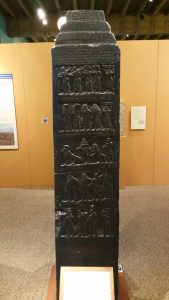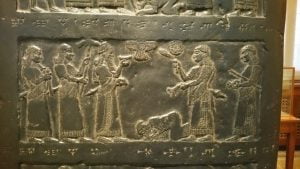
Past the palace walls in the corner on the left are two amazing finds of biblical significance.
Black Obelisk of Shalmanezer
This is a full-scale replica of the original that is in the British Museum. Shalmanezer was an Assyrian king. On one side, 2nd row, is Jehu, with his attendants, bowing down paying homage and tribute.

The cuneiform (wedge-shaped writing system) underneath the carving says, “Tribute of Yahua, house of Omri.” It was discovered in 1846 and was the earliest biblical figure confirmed outside of the Bible. The full text is dated to 841 BC and says:
“The tribute of Jehu, son of Omri: I received from him silver, gold, a golden bowl, a golden vase with pointed bottom, golden tumblers, golden buckets, tin, a staff for a king [and] spears.”
Interestingly, the only carving we have of an Israelite king, comes from a pagan source. This is because Israelites were forbidden from making images.
Exodus 20:4 – “Thou shalt not make unto thee any graven image, or any likeness of any thing that is in heaven above, or that is in the earth beneath, or that is in the water under the earth …”
Why did Jehu need to pay tribute? He started out well, but did not finish well.
2 Kings 10:30-31 – “And the LORD said unto Jehu, Because thou hast done well in executing that which is right in mine eyes, and hast done unto the house of Ahab according to all that was in mine heart, thy children of the fourth generation shall sit on the throne of Israel. But Jehu took no heed to walk in the law of the LORD God of Israel with all his heart: for he departed not from the sins of Jeroboam, which made Israel to sin.”
Mordechai, Daniel, and the 3 Hebrews would bow to God but could stand before any King. Those who fail to bow to God, will be someone’s slave.